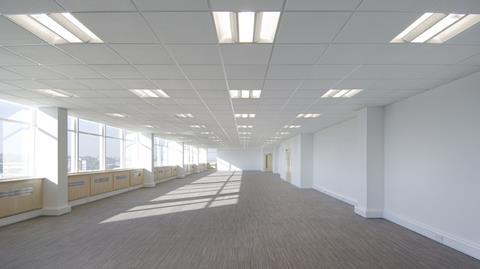London office rents and lease lengths are taking a significant hit as a result of the global pandemic, according to new research in the sector, with the lessons of the global financial crisis (GFC) suggesting the worst is yet to come.

Global membership body the Society of Industrial & Office Realtors (SIOR) suggests that prime rents in the UK capital are unlikely to recover to pre-pandemic levels before 2022, with key city market rents having already fallen by as much as 8% quarter-on-quarter.
Meanwhile, new data from cloud-based, commercial property management platform Re-Leased finds that average commercial lease lengths in the UK dropped to 27.4 months in June, an 18-month low, according to Re-Leased's commerical real estate index Credia.
London leasing activity in decline
A combination of stalled deals, increasing vacancy and lease breaks has slowed leasing activity in London down to 1.2 million ft2 (111,500 m2) in Q2 2020, representing a 57% drop on the previous quarter, according to figures from DeVono Cresa.
Based on the same data from DeVono Cresa, this has already impacted rental values with prime rents on Grade A space dipping by an average of 3% since Q1 2020. The biggest falls have been recorded in traditionally robust submarkets such as Mayfair (-8%) and Soho (-8%).
Paul Danks, director at DeVono Cresa, and president-elect of SIOR Europe, said: 'As a result of the ongoing pandemic, we expect the lettings market to remain subdued compared with historical levels mixed with increased appreciation for flexible office space. This sudden increase in availability is already prompting a swing in the balance of power back towards the tenant.'
Though these figures are unsurprising, Nick McCalmont-Woods, CEO of McCalmont-Woods Real Estate, believes there is potentially worse news yet to come as the UK officially enters its first recession since the GFC.
'During the GFC of 2008/2009 we saw an initial softening of rents in the immediate aftermath of the Lehman Brothers’ downfall. Yet, as the economy contracted and the recession deepened, landlords were persuaded to offer far more competitive terms to attract a dwindling pool of occupiers,' he said.
Analysis from McCalmont-Woods Real Estate shows that, though London’s prime office rents experienced a decline of between 9% and 21% over the first twelve months of the GFC, it was another 12 months before the market hit bottom with prime rents having fallen between 16% and 39% from their peak at the end of 2007.
'As occupiers adjust to the impact of Covid-19 on their businesses and scale back, delay or even shelve some office requirements altogether, we expect the pattern of rental decline from the GFC to repeat itself and, if anything, it may be exacerbated further in the event that significantly more tenant/occupier controlled space is released back on to the market as businesses adopt new working practices in the long-term,' McCalmont-Woods added.
Lease lengths suffering
Meanwhile, average commercial lease lengths in the UK dropped to 27.4 months in June, an 18-month low, according to Credia, the Commercial Real Estate index by Re-Leased. Credia is a new monthly index that draws on aggregated data from over 20,000 leases in the UK.
The index tracks the 3-month rolling average of new leases signed, excluding coworking and flexible space leases. It reveals the coronavirus pandemic has escalated the trend for shorter leases and the pressure on long-term security of income for landlords.
In May, the average fell below 30 months for the first time since the start of 2019, and continued downwards into June, which saw an 18-month low compared to a high of 48 months in January last year.
Tom Wallace, Re-Leased’s CEO, said 'Before coronavirus there was already a tenant driven shift towards greater flexibility. Average lease lengths had been steadily declining for a number of years. The pandemic has accelerated this trend and, in a very short space of time, average lease lengths have been driven to sub 30-month averages.'
The latest Credia Index also reveals there is a high potential vacancy risk in the UK. Currently, 37.7% of tenancies are on a periodic lease, with an absence of an agreed expiry. From a legal standpoint, these tenants can vacate as they like, potentially adding to landlord woes.










